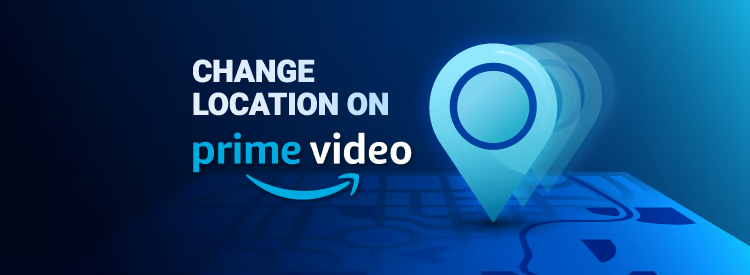Amazon Prime Video, best known for its exclusives, such as The Boys and various others, offers an extensive catalog. However, the geo-restrictions make it a hassle to globally access these titles. That’s where a reliable VPN can be of help to you. By connecting to a VPN server, you can easily hop these restrictions while ensuring enhanced privacy.
That said, this guide walks you through why Amazon Prime blocks VPNs, whether Amazon Prime Video works with VPNs, and how you can trick Amazon Prime Video’s location to enjoy seamless streaming from anywhere.
Why Amazon Prime Blocks VPNs
But, here’s what causes these geo-restrictions. The original producers have license agreements with the streaming service. For example, a specific title that’s available in the US will not be accessible in Jordan. However, connecting to a VPN can help resolve this issue.
When a user connects to Amazon Prime via a VPN, the platform checks the IP address and subnet mask to determine whether the IP is associated with a VPN.
Meanwhile, a subnet mask helps divide the IP address into the network and host portions, which makes it easier for Amazon to identify traffic coming from VPNs. When an IP address falls into a recognized VPN subnet, Amazon Prime blocks it, preventing users from accessing content while using the VPN.
The problem arises because VPNs are often used to spoof locations, allowing users to bypass regional restrictions. As streaming services like Amazon Prime aim to uphold their licensing agreements, they implement sophisticated methods to detect and block VPN traffic.
Does Amazon Prime Video Work With a VPN?
The short answer is yes—but it depends on the VPN service you are using. Not all VPNs work with Amazon Prime Video. Many VPN services fail to bypass Amazon’s geo-restrictions because their IP addresses are recognized and blocked. However, some VPN providers continuously update their IP address pools, ensuring that their servers remain undetected by Amazon’s VPN blocking mechanisms.
Here’s how it works: A reliable Amazon Prime Video VPN will mask your actual IP address and change it according to the country you’re trying to access content from. This way, Amazon Prime thinks you are in that country, allowing you to unlock that region’s content library. However, it’s important to note that Amazon Prime is constantly updating its VPN detection technologies, so not all VPNs can guarantee uninterrupted access.
When choosing a VPN for Amazon Prime Video, you should look for these key features:
1. Dedicated Streaming Servers
Different VPNs have servers that are primarily optimized for streaming, ensuring higher speeds and better performance.
2. Wide Server Network
A VPN with a large number of servers in multiple countries increases your chances of successfully bypassing geo-blocks.
3. High-speed Connections
Streaming in high definition requires fast internet speeds. A good VPN should offer high-speed connections with minimal lag or buffering.
4. Strong Privacy Protections
A VPN should also protect your personal information by encrypting your data using protocols like OpenVPN or WireGuard.
How to Trick Amazon Prime Video Location
Here’s a step-by-step guide on how to use an Amazon Prime Video VPN to trick your location and enjoy seamless streaming.
1. Choose a Reliable VPN Provider
First, select a VPN provider that works with Amazon Prime Video. You can opt for services like ExpressVPN, NordVPN, or Surfshark, all of which are known for their ability to unblock streaming platforms. Ensure the VPN has servers in the country where you wish to access the content.
2. Download and Install the VPN App
After getting the VPN, install the VPN app on your device. Most VPN services are compatible with various devices, including smartphones, tablets, smart TVs, and computers.
3. Connect to a VPN Server
After installing the VPN, open the app and connect to a server in the country whose content you want to access. For example, if you wish to watch content from the U.S. Amazon Prime library, connect to a U.S.-based server.
The VPN will mask your real IP address and give you a new IP from the region of the server you’re connected to. Ensure the subnet mask of your new IP doesn’t reveal VPN traffic to Amazon Prime Video.
4. Clear Cache and Cookies
Before accessing Amazon Prime, it’s a good idea to clear your browser’s cache and cookies. These can sometimes store location data from previous sessions, which could alert Amazon Prime that you’re trying to bypass geo-restrictions.
5. Open Amazon Prime Video and Enjoy Streaming
Once you’ve connected to the VPN server and cleared your cache, head over to Amazon Prime Video. You should now have access to the content library of the region where the server is located. You can browse through the content and start streaming without interruptions.
6. Troubleshoot if Blocked
If Amazon Prime Video detects that you’re using a VPN and blocks your connection, try switching to a different server within the same country. Many VPNs provide multiple servers in the same region to help users bypass geo-restrictions. You may also want to contact your VPN provider’s support for recommendations on which servers work best for streaming.
Conclusion
Using an Amazon Prime Video VPN allows you to access content from different regions, offering you more variety in movies and TV shows. However, not all VPNs work seamlessly with Amazon Prime due to the platform’s VPN-blocking mechanisms.
A reliable VPN provider with a large server network, fast speeds, and strong privacy protections is key to successfully unblocking Amazon Prime Video. Meanwhile, always ensure that your VPN is up to date and is not flagged by Amazon, and enjoy uninterrupted access to your favorite shows!







